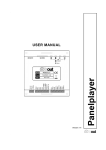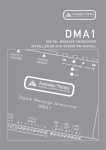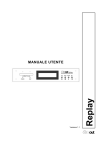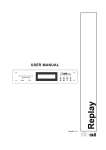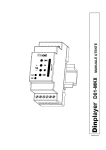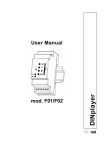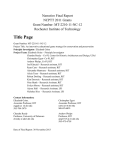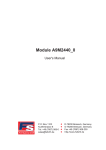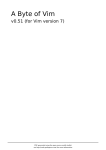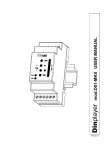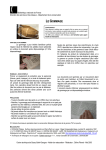Download Panelplayer Manual
Transcript
0 Panelplayer USER MANUAL Version 1.1 Panelplayer User Manual v.1.1 Warranty Panelplayer has a 24 month warranty on the electronic parts, running from the date of purchase. The warranty will not be valid in case of tampering with the device or in case personnel not authorised by the manufacturer or by the authorised dealer should carry out work on it. N.B. responsibility of the purchaser: in case of operation under warranty, the device must be packaged so as to prevent damage during transport and shipped to the manufacturer together with all the accessories. Warranty rules 1. In order to exercise his warranty rights, the purchaser must enclose with the device a copy of evidence of purchase duly stamped by the dealer (bill/invoice). 2. The warranty lasts for 24 months for the electronic parts. The warranty is granted at the point of sale or else directly requested from the manufacturer. 3. The warranty only covers damage to the product which makes it work badly. 4. Work under warranty will only mean repairing or replacing, free of charge, any parts acknowledged to be defective during manufacture or in their material, including labour costs. 5. The warranty does not apply to damage caused by negligence or failure to comply with the instructions, or damage caused by unauthorised people, with a special reference to the outside parts. 6. Also, the warranty does not apply to damage caused to the device by connection to unsuitable power sources. 7. The warranty does not cover parts subject to wear after use, or the container if the material is not defective. 8. The warranty does not include transport costs, which will be paid for by the purchaser in relation to the manner and time of transport. 9. The warranty will run out after 24 months have elapsed. In this case, service will be provided charging for the parts replaced, labour costs and transport according to the current rates. 10. Any dispute will be settled exclusively before the Court of Law of Venice. Page 1 Panelplayer User Manual v.1.1 TABLE OF CONTENTS 1. Introduction 1.1 1.2 1.3 1.4 1.5 1.6 1.7 2. Installation 2.1 2.2 3. What is the configuration file? Content of the configuration file How it is managed by Panelplayer Preparing the file Memorising the files in the Flash memory Audio adjustment parameters Timing and switchover parameters Diagram of the operating parameters Input management parameters Infrared movement sensor management parameters Scheduled operation 5.1 5.2 5.3 5.4 6. Command description Connection description Power supply Logical inputs IN/OUT 8 - Vlink input/output Serial RS485 connection Pre-amplified audio input Pre-amplified audio output Amplified audio output Configuration file 4.1 4.2 4.3 4.4 4.5 4.6 4.7 4.8 4.9 4.10 5. Content of the Panelplayer kit Notices Description and connections 3.1 3.2 3.3 3.4 3.5 3.6 3.7 3.8 3.9 4. What is Panelplayer? What is Mp3? Encoder Decoder Player Wave Audio compression in various formats Introduction to timed operation The palimpsest file – palin.txt MIXER function AVC function – automatic control of the output volume Playlist operation 6.1 6.2 6.3 6.4 6.5 6.6 6.7 6.8 6.9 Introduction to playlist mode operation What is a playlist file? Playlist activation by logical inputs - MPLL (Mode PLayList) parameter Stop & Play Priority Playlist Priority Playlist Stop & Play Standard Playlist Standard Playlist Stop & Play Restart Playlist Restart Playlist Page 2 Panelplayer User Manual v.1.1 7. Operation with logical inputs 7.1 7.2 8. Special operations 8.1 8.2 9. Introduction to the logical input operation mode Binary input command codes Connection of two Panelplayers with different programming Amplifier connection to 40W bridge RS485 serial communication 9.1 9.2 9.3 9.4 9.5 9.6 9.7 9.8 9.9 9.10 9.11 9.12 9.13 9.14 9.15 9.16 9.17 9.18 9.19 RS485 communication Serial port communication parameters (config.txt) Framing error on master NAK reply by Panelplayer Transmitting a command by master How to read the figures of the dedicated protocols When the Master delivers a command to Panelplayer Basic format of the dedicated protocols Basic set-up of the data transmission Control codes Address (ADD) Command (CMD) CheckSum (CHK) Basic protocol Basic protocol with CheckSum Basic protocol with CR and LF Basic protocol with CheckSum, CR and LF List of commands Error codes 10. Specifications 10.1 10.2 10.3 Technical features Maintenance and conservation Disposal Page 3 Panelplayer User Manual v.1.1 1 Introduction 1.1 What is Panelplayer? Panelplayer is a sophisticated amplified player of audio MP3 with a solid state memory, designed to manage sequences of audio messages, musical items, commercial communications and all kinds of audio MP3 files in a rapid, effective and interactive way. Coupled with switches, touch-sensors or infrared movement sensors, it permits one to create info-interactive areas, didactic and museum routes, information totems for trade fairs and expositions, musical shows and interactive points for commercial promotions. 1.2 What is Mp3? Mp3 is an acronym for Mpeg-1 layer 3. This is an audio compression standard which eliminates sounds which the human ear cannot hear via a psycho-acoustic algorithm. The purpose of this compression is to reduce the space taken up by an audio file while still ensuring excellent quality. The greater the compression, the less the audio quality. The right compromise, which guarantees a quality comparable to that of a Compact Disc, is 128 Kbps (thousands of bits per second) which represents the most widely used manner, and reduces the size of an uncompressed file by 10 times. 1.3 Encoder Software which compresses a CD audio or wave file in MP3. There are many programmes of this kind, and it is virtually impossible to say which is the best. Here is an internet site where you can download freeware software suitable for various operating systems: www.mp3server.4t.com 1.4 Decoder Software which decompresses an MP3 audio file in order to send it to a digital-analog converter and reconstruct the original audio signal. 1.5 Player Hardware and software system able to read MP3 audio files. Panelplayer is able to carry out this function. 1.6 Wave High quality audio format (extension .wav), compatible with the tracks of normal music CD’s. If one uses a wave file in format 44.1 KHz/sec. at 16 bit in stereo, one will get exactly the same quality as a music CD, but the size of the file is about 10Mb per minute. 1.7 Audio compression in various formats. The following graphic shows the space taken up by an uncompressed audio file of about 5 minutes (.wav) and compressed in MP3 at 128Kbps (MP3). Wave MP3 51,1 MB 4,6 MB Page 4 Panelplayer User Manual v.1.1 2 Installation 2.1 Content of the kit Panelplayer - n° 1 Panelplayer device; n° 1 Panelplayer user manual; n° 1 flash memory. 2.2 Notices 1. Panelplayer has been designed and made to work only with the following mains power supply: 12÷15VAC, 12÷24VDC. 2. The device must be serviced only by qualified staff. 3. Do not put objects inside the device through the openings, in order to prevent the risk of fire or shock. 4. Disconnect the device from the power socket before cleaning. Clean the device using a soft, dry cloth. Do not use liquids or spray which can contain flammable substances. Page 5 Panelplayer User Manual v.1.1 3 Description and connections 3.1 Command description 1- Connector for outside connection of the memory and command buttons. 2- Flash memory introduction slot for Secure Digital or MultiMedia Card. 3- Command keys: = (brief pressure) precedent MP3 file / (prolonged pressure) reduce output volume = STOP = PLAY = (brief pressure) next MP3 file / (prolonged pressure) increase output volume 4- Red LED: 5- Green LED: lit = device is live. lit = MP3 file playing; blinking = Panelplayer in pause/STOP. IMPORTANT: • • volume control with the keys is active only during the playing of the MP3 file. pressing STOP during play, Panelplayer remains in pause excluding all the logical inputs until reactivation with the PLAY key. This condition is indicated by the blinking green LED. Page 6 Panelplayer User Manual v.1.1 3.2 Connection description 6- VAC/DC Input feed 12÷15VAC or 12÷24VDC. 6- +12VDC Auxiliary + 12Vdc voltage, available for input activation or outside feed sensors. MAX. 100mA. 7- GND Ground for input activation using outside contacts; auxiliary ground voltage. 7- IN1 7- IN2 7- IN3 7- IN4 7- IN5/485A 7- IN6/485B 7- IN/OUT7 7- IN/OUT8 8- IN L 8- GND Ground signal of pre-amplified audio input. 8- IN R Pre-amplified audio input R channel, for outside music sources (SAT, DAB, CD, etc.) with Mixer function. 9- OUT L Pre-amplified audio output L channel. 9- GND Ground signal of pre-amplified audio output. 9- OUT R Pre-amplified audio output R channel. Multi-function input for activating 1.mp3 file or 1.m3u playlist (direct or bit 0 in binary combination). Multi-function input for activating 2.mp3 file or 2.m3u playlist (direct or bit 1 in binary combination). Multi-function input for activating 4.mp3 file or 3.m3u playlist (direct or bit 2 in binary combination). Multi-function input for activating 8.mp3 file or 4.m3u playlist (direct or bit 3 in binary combination). Multi-function input for activating 16.mp3 file or 5.m3u playlist (direct or bit 4 in binary combination). Configurable for serial RS485 communication (see chap. 9). Multi-function input for activating 32.mp3 file or 6.m3u playlist (direct or bit 5 in binary combination). Configurable for serial RS485 communication (see chap. 9). Multi-function input/output for activating 64.mp3 file or 7.m3u playlist (direct or bit 6 in binary combination). Multi-function input/output for activating 128.mp3 file (direct or bit 7 in binary combination). Configurable for outside applications. 0=standby 1=in play (+12V). Permits two Panelplayers to be connected in cascade for the synchronised management of the musical bases and commercials and spots in a scheduled time frame (connection Vlink, par. 8.1). Pre-amplified audio input L channel, for outside music sources (SAT, DAB, CDE, etc.) with Mixer function. 10 - SPK L Amplified 20W audio output for speaker, L channel. 10 - GND Ground signal of amplified audio output. 10 - SPK R Amplified 20W audio output for speaker, R channel. Page 7 Panelplayer User Manual v.1.1 3.3 Power supply Panelplayer may operate with the following voltage power supplies: 12÷15VAC, 12÷24VDC. It is recommended to use the mains adaptor furnished with the device. The red POWER LED lights up when it is turned on with active feed. 3.4 Logical inputs Panelplayer has six/eight multi-function logical inputs to control the playing of the playlists or direct calling up of individual audio files. The pins are: 123456789- GND IN 1 IN 2 IN 3 IN 4 IN 5 IN 6 IN 7 IN 8 In order to activate the playing of a file, connect the desired GND input (or the desired inputs when one is operating in binary logic). 3.5 IN/OUT 8 - input/output Vlink Programmable input/output to connect two Panelplayers in cascade, for synchronised management of musical playlists with commercials at scheduled introduction without interruptions. Vlink: 0 = standby 1 = in play (+12V). 3.6 Serial RS485 connection Panelplayer can be connected through serial gate, to a RS485 bus that can be controlled by a system master or by a computer. To enable the RS485 gate (pin IN5/485A and IN6/485B), raise the cover of the device and move the relative jumpers (see para. 9.1). 3.7 Pre-amplified audio input Pre-amplified STEREO L+R audio input for outside music source (SAT, DAB, CD, etc.) with Mixer function to mix a music source with scheduled commercials; extractable terminal strip. 3.8 Pre-amplified audio output Pre-amplified STEREO L+R audio output on extractable terminal strip. 3.9 Amplified audio output Amplified STEREO 20W+20W audio output on extractable terminal strip. Connect the outside 4/8Ω speakers to the SPK L/GND and SPK R/GND terminal strip. Important! Use a speaker with equal or greater power to that supplied to the amplifier within Panelplayer. It is recommended to cable the device far from power cables; the two cables that connect the speaker with Panelplayer could be a potential source of interference. Page 8 Panelplayer User Manual v.1.1 4 Configuration file 4.1 What is the configuration file? Panelplayer is a very versatile device which can be adapted to the needs of the application in which it is used. Different applications may require adjustment of volume, tone, loudness, special parameters of communication or timing. The text file, called ‘configuration file’ and stored in the main directory of the flash memory, together with the audio files, makes it possible to programme the various parameters of Panelplayer. This file must be assigned the name config.txt (this extension has been used so it can be modified by any text editor, including those for portable PocketPC terminals). 4.2 Content of the configuration file Each line of the configuration file consists of: • Mnemonic code of the parameter to be set. It always consists of four CAPITAL alphanumeric characters, and must always be at the beginning of the line. No more than one parameter is permitted on the same line. • Separating character. ‘=’. This MUST be inserted just after the mnemonic code, without any spacing or tabulation character. • The relevant numerical parameter expressed as a decimal, to be inserted directly after the separation character, without any spacing or tabulation character. Example: LMP3=14 LOUT=14 LLIN=14 LLI2=5 LLOU=10 LTRE=10 LBAS=10 MOMD=0 4.3 How it is managed by Panelplayer At the time the device is turned on, or when the flash memory is inserted, Panelplayer will start to read the main directory of the memory; once it has found the file config.txt, it interprets the parameters inserted in each line, memorising them permanently in its internal memory, of a non volatile kind. The parameters therefore stay in memory even after the device has been turned off. This is why it is not indispensable for the configuration file to be always present in the flash memory: once all the parameters have been acquired, this file can also be deleted. NOTE: If it is necessary to configure various Panelplayers with the same parameters, one can prepare a single flash memory with the appropriate config.txt file, alternately insert this memory on all the modules to be configured, then insert the memory with the audio files only. 4.4 Preparing the file To create the file, one can use an ordinary text editor (like Windows Notebook). The file must be saved as a pure text file (.txt). Should other programmes be used (e.g. Microsoft Word) one must be careful to save the document as “text only”: otherwise, control characters would be inserted which would make it impossible for Panelplayer to interpret this file. Page 9 Panelplayer User Manual v.1.1 4.5 Memorising the files in the flash memory The configuration file and all the MP3 audio files can be memorised in the flash memory via a special USB reader/writer for PC. 4.6 Audio adjustment parameters Panelplayer allows for the following audio adjustments: • Independent adjustments of the MP3 file level, INL/INR music source input and general amplified/pre-amplified output. • Adjustment of loudness level. • Separate adjustment of high and low levels. • Adjusting the level of the musical background while delivering the spots. • Activation/deactivation audio amplifier muting in output. The following tables show the relation between the value set in the configuration file and the actual value of the audio parameter. Mnemonic Description MP3 decoder output level (value between 0 and 20 in decimal). LMP3 LOUT LLIN LLI2 LLOU LTRE LBAS MOMD Level audio output LINE OUTPUT (value between 0 and 20 in decimal). Input level LINE INPUT (value between 0 and 20 in decimal). Background level LINE INPUT (value between 0 and 20 in decimal). Loudness level (value between 0 and 20 in decimal). High tone level (value between 0 and 20 in decimal). Low tone level (value between 0 and 20 in decimal). Mode output muting deactivation (0=OFF/1=ON ). LMP3 (MP3 decoder output level) Value 0 1 2 3 4 5 6 7 8 9 10 11 12 13 14 15 16 17 18 19 20 OFF 2% 5% 9% 14% 20% 26% 33% 40% 48% 56% 66% 77% 88% 100% 112% 128% 144% 161% 178% 200% Level 0dB +6dB LOUT (general output amplified/pre-amplified level) Value 0 1 2 3 4 5 6 7 8 9 OFF -55 -35 -28 -23 -20 -17 -14 -12 -10 Level dB dB dB dB dB dB dB dB dB 10 11 12 13 14 15 16 17 18 19 20 -8 dB -6 dB -4 dB -2 dB 0 dB +2 dB +4 dB +6 dB +8 +10 +12 dB dB dB LLIN (input level INL/INR) Value 0 1 2 3 4 5 6 7 8 9 OFF -55 -35 -28 -23 -20 -17 -14 -12 -10 Level dB dB dB dB dB dB dB dB dB 10 11 12 13 14 15 16 17 18 19 20 -8 dB -6 dB -4 dB -2 dB 0 dB +2 dB +4 dB +6 dB +8 +10 +12 dB dB dB LLI2 (input level INL/INR of the background during the playing of the MP3 file) Value 0 1 2 3 4 5 6 7 8 9 OFF -55 -35 -28 -23 -20 -17 -14 -12 -10 Level dB dB dB dB dB dB dB dB dB 10 11 12 13 14 15 16 17 18 19 20 -8 dB -6 dB -4 dB -2 dB 0 dB +2 dB +4 dB +6 dB +8 +10 +12 dB dB dB LLOU (loudness level) Value 0 Level 0 +0,5 + 1 +1,5 + 2 +2,5 + 3 + 4 dB dB dB dB dB dB dB dB 1 2 3 4 5 6 7 8 9 10 11 12 13 14 15 16 17 18 19 20 + 5 + 6 + 7 + 8 + 9 + 10 +11 + 12 + 13 + 14 + 15 + 16 + 17 dB dB dB dB dB dB dB dB dB dB dB dB dB Page 10 Panelplayer User Manual v.1.1 LTRE (high tone level) Value Level 0 1 -12 -10 dB dB 2 3 4 5 6 7 8 9 10 11 12 13 14 15 16 17 18 19 20 -8 dB -7 dB -6 dB -5 dB -4 dB -3 dB -2 dB -1 dB 0 dB +1 +2 +3 +4 +5 dB dB dB dB dB +6 dB +7 dB +8 +10 +12 dB dB dB LBAS (low tone level) Value Level 0 1 -12 -10 dB dB 2 3 4 5 6 7 8 9 10 11 12 13 14 15 16 17 18 19 20 -8 dB -7 dB -6 dB -5 dB -4 dB -3 dB -2 dB -1 dB 0 dB +1 dB +2 +3 +4 +5 dB dB dB dB +6 dB +7 dB +8 +10 +12 dB dB dB MOMD (Mode Output Muting Disable) 1 = Muting deactivated (amplifier power always active). MOMD 0 = Muting active. The power amplifier is active only during the playing of the MP3 files. 4.7 Timing and switchover parameters One can set the fade-off time, the reaction time of the automatic output volume and the advance time for starting the spot before the end of the piece of music. Example: Mnemonic TFOU=15 TFIN=15 TAVC=3 TADU=15 Description of timing parameter TFOU Setting the Fade-Out time in 1/10 of one second (value between 1 and 30 in decimal). TFIN Setting the Fade-In time in 1/10 of one second (value between 1 and 30 in decimal). TAVC Setting the reaction time of the automatic output volume control. Setting the advance Play time of the spot in 1/10 of one second between Panelplayers in cascade (value between 0 and 20 in decimal). TADU TFOU (fade OUT): setting the fading time of the INL/INR before playing the MP3 file (spot). Value Time 1 1/10 second 2....4 5 ½ second 6....9 10 11...14 15 16...19 20 21...24 25 26...29 30 1 1,5 2 2,5 3 second seconds seconds seconds seconds TFIN (fade IN): setting the fading time of the INR/INL after playing the MP3 file (spot). Value Time 1 1/10 second 2....4 5 ½ second 6....9 10 11...14 15 16...19 20 21...24 25 26...29 30 1 1,5 2 2,5 3 seconds second seconds seconds seconds TAVC: Setting the reaction time of the automatic output volume control. Value 0 1 2 3 4 2/10 second 8 seconds Time OFF 2 seconds 4 seconds TADU: Setting the advance Play time of the spot in 1/10 second between Panelplayers in cascade. Value Time 1 1/10 second 2....4 5 ½ second 6....9 10 11...14 15 16...19 20 21...24 25 26...29 30 1 1,5 2 2,5 3 seconds second seconds seconds seconds Page 11 Panelplayer User Manual v.1.1 4.8 Diagram of the operating parameters Page 12 Panelplayer User Manual v.1.1 4.9 Input management parameters The playing of the files takes place by activating the available logical inputs, the activation modes are set through the IMOD, TPCM MICP and MIRS parameters inserted in the configuration files. Example: Mnemonic IMOD=0 TPCM=10 MICP=1 MIRS=0 Description of timing parameter IMOD Setting the mode of input active high or active low. TPCM Setting the persistence time of the input command (time to wait before Panelplayer is able to interpret the input command) expressed in decimals of milliseconds (value between 0 and 255 in decimal). MICP MIRS Setting Mode Input Continuous Play Setting Mode Input ReStart IMOD (Input management mode) IMOD 0= active-low input mode; the functioning of the input is connected to the ground/GND of the device. 1= active-high input mode; the functioning of the input is applied with a positive voltage between 5 and 12Vdc. TPCM (Time persistence input command mode) TPCM 0 =no delay 1 =10mSeconds 2 =20mSeconds 100= 1 second 200= 2 seconds 250= 2,5 seconds MICP (Mode Input Continuous Play) MICP 0=having terminated the playing of the codified file, requested from the input code, Panelplayer goes in standby. 1=the requested codified file is continuously played until the relevant input code is inserted. MIRS (Mode input Restart) MIRS 0=repeated activation or deactivating of the same input code does not influence the playing of the relevant file. Only the activation of a different code can block the playing underway and activate the playing of the new requested file. 1=in the moment in which an input code is enabled the playing of the of the relevant file from its beginning takes place, even if it is already in play. Page 13 Panelplayer User Manual v.1.1 4.10 Infrared movement sensor management parameters IMPORTANT: the following parameters are enabled exclusively for the IN1 input. Example: Mnemonic PYDT PYDT=1 PYDL=10 TAPL=0 RSPL=3 Description Activation IR sensor (0=OFF/1=ON ). Delay time between two activations of the IR sensor (value between 0 and 240 in decimal). Setting of the AUTOPLAY time for playing of a message when the IR sensor is not activated (value between 0 and 240 in decimal). Delay time of the Play message from the activation of the IR sensor (value between 0 and 20 in decimal). PYDL TAPL RSPL PYDT (activation infrared movement sensor) 1 = IR sensor activated 0 = sensor deactivated PYDT PYDL (pause between two activations of the IR sensor) Value 0 1 Time IR 1 2 3 4 5 10 20 30 60 120 180 240 2 3 4 5 10 20 30 1 2 3 4 second seconds seconds seconds seconds seconds seconds seconds minute minutes minutes minutes TAPL (setting AUTOPLAY time for playing files when the IR sensor is not activated) Value Time 0 1 2 3 4 5 6 12 18 30 60 180 240 Not 10 20 30 40 50 1 2 3 5 10 30 40 managed seconds seconds seconds seconds seconds minute minutes minutes minutes minutes minutes minutes RSPL (delay time of the Play message from the activation of the IR sensor) Value 1 Time 1/10 ½ 1 second second second 2....4 5 6....9 10 11...14 15 1,5 seconds Page 14 16...19 20 2 seconds 21...24 25 2,5 seconds 26...49 50 5 seconds Panelplayer User Manual v.1.1 5 Scheduled operation 5.1 Introduction to timed operation When the flash memory is inserted, Panelplayer will analyse its contents and – depending on the files which are present – will automatically set the mode of operation. In the presence of the PALIN.TXT file, Panelplayer plays the sequence of communiqués in a cyclical emission (one hour cycles) called PALIMPSEST which are contained in the same PALIN.TXT file. 5.2 The palimpsest file – palin.txt With Panelplayer one can draw up a sequence or list of communiqués to be played according to pre-set intervals. This list is a simple text file (palin.txt) which contains the indication in minutes (00:00÷00:59) and the names of the MP3 files to be played. There are a few simple rules on how to set the palimpsest; first of all, you must set the time. Es: 00:10 N.B. It is very important to start a new line of text with this, and to separate the hours from the minutes using the character (:) On the same line, you must then introduce the names of the MP3 audio files (max. 8 characters). You can choose among various kinds of introduction: 1. separating character [Tab] between one spot and the next: E.g.: 00:10 spot01 spot02 spot03 2. comma (,) between one spot and the next: E.g.: 00:10,spot01,spot02,spot03 3. semicolon (;) between one spot and the next: E.g.: 00:10;spot01;spot02;spot03 Once the insertion has been completed, the file will appear as in the following example: 00:00 00:05 00:10 00:15 00:20 00:25 00:30 00:35 00:40 00:45 00:50 00:55 Spot04 Spot09 Spot11 Spot01 Spot12 Spot16 Spot09 Spot05 Spot02 Spot04 Spot02 Spot09 Spot07 Spot17 Spot02 Spot08 Spot03 Spot17 Spot10 Spot11 Spot11 Spot07 Spot11 Spot11 Spot03 Spot06 Spot05 Spot12 Spot13 Spot14 Example of palin.txt file with cyclical emission at intervals of 5 minutes of commercial spots An example of the reading and functioning of a timetable bar is provided below: 00:05 00:11 Spot05 Spot01 Spot11 Spot07 Spot12 Spot03 Spot13 Page 15 Spot14 Panelplayer User Manual v.1.1 In this case, Panelplayer remains in standby for 5 minutes from the moment it is turned on; at the 5th minute Panelplayer fades out the input audio signal in order to play the 00:05 bar, composed of 5 files/spots. Once the bar has finished, Panelplayer brings the input audio signal to its precedent value and remains in standby until reaching the 11th minute, fading in the input audio to play the 00:10 bar, composed of 3 files/spots. IMPORTANT! Using the pre-amplified audio input, verify the setting of the LLIN, LLI2 and MOMD parameters inserted in the configuration files (par. 4.6). Programming limits: Max. programming permitted……………………… Max. quantity of hour bars…………………………. Max. quantity of commercials per bar…….…….... Max. quantity of commercials per palimpsest…… 1 hour (cyclic) 60 bars 8 spots/file 500 spots/file from 00:00 to 00:59 5.3 MIXER function Panelplayer has an audio input for connection to outside music sources, with a mixer function to mix this source with the files played by flash memory (see par. 8.3). At the time scheduled for delivering the advertising bar, Panelplayer fades out the input audio signal from the level LLIN to the level LLI2, according to a programmed fade TFOU. Then the MP3 file of the bar with level LMP3 is played, mixed with the outside audio source, present in the background with level LLI2. Once the whole hour bar has been finished, Panelplayer brings the input audio signal back to the level LLIN according to a programmed fade TFIN. 5.4 AVC function – automatic control of the output volume Panelplayer has an automatic control of the output volume (parameter TAVC, par. 4.7) which allows you to normalise the level of the audio contributions: signal from LINE IN (radio, CD, other Panelplayer). This allows you to make less evident any differences of levels among the various MP3 files being played. Page 16 Panelplayer User Manual v.1.1 6 Playlist operation 6.1 Introduction to playlist mode operation When the flash memory is introduced, Panelplayer analyses its content on the base of the presence of the relevant files, and automatically sets the following operation mode: 1. 2. FILE PLAYLIST:TXT: audio player with pieces in sequence according to the list present in the files. FILE 1.M3U, 2.M3U, 3.M3U, 4.M3U, 5.M3U, 6.M3U, 7.M3U: audio player of the sequence contained in the files depending on the logical input activated: 1.m3u = IN 1 2.m3u = IN 2 3.m3u = IN 3 4.m3u = IN 4 5.m3u = IN 5 6.m3u = IN 6 7.m3u = IN 7 During play the four command buttons REW, STOP, PLAY and FWD are activated. 6.2 What is a playlist file? Panelplayer is able to follow a sequence or list of music pieces; this play list is a simple text file called playlist.txt which can be inserted in the main directory of the same memory containing the audio files (this extension is used so it can be modified via a handy PocketPC portable terminal). Follow a few, easy rules to set the sequence: Example with numbers: 1 3 7 9 5 01 005 Example with names: intro part 1 part 2 monologu music part 3 finale IMPORTANT: • • • Rename the MP3 audio files with numbers or names with max. 8 characters. Do not write in the extension (.mp3) Max. 500 pieces per playlist Fit the memory into its seat and wait for Panelplayer to read the playlist in order to check the list of pieces contained. At the end of the reading operation, if the names of the pieces have been fitted in correctly, Panelplayer will automatically start to play the musical items in the programmed sequence or it will await the activation of a logical input. 6.3 Playlist activation by logical inputs - MPLL (Mode PLayList) parameter The seven available playlists, activated by the logical inputs, can be played with different modes, depending upon the varying needs. To choose these different manners of operation, you must work directly on the configuration parameter MPLL (Mode PLayList) inserted in the file config.txt. When the flash memory is put in, Panelplayer, depending on the configuration of the parameter MPLL in the file config.txt, will switch over to the relevant manner of operation. • IMPORTANT: the names of the 7 playlists are fixed • the loading times of the Playlists may last even tens of seconds, in the meantime, Panelplayer is not able to play. Page 17 Panelplayer User Manual v.1.1 6.4 MPLL=10: Stop & Play Priority playlist Operating mode: • Activated the input, the relative item in the Playlist is played: at the end of it, Panelplayer goes in standby, awaiting a further activation. Activating the input once again or if the activation remains, the successive file is played. • Repeated activations or deactivations of the same input or of other inputs does not influence the playing of the file. • The position of the last item played is stored in memory, in order to start out again always by the next one in case of restart. • The playlist is activated in loop, as long as the activation of the relative logical input remains activated. INPUT RELATIVE PLAYLIST none = Standby IN 1 = 1.m3u IN 2 = 2.m3u IN 3 = 3.m3u IN 4 = 4.m3u IN 5 = 5.m3u IN 6 = 6.m3u IN 7 = 7.m3u IN 8 = VLINK function N.B. If several inputs are activated, the playlist relevant to the lowest input is activated. For example, if IN4 and IN5 are active, the playlist 4.m3u is played. Page 18 Panelplayer User Manual v.1.1 6.5 MPLL=11: Priority playlist Operating mode: • Activated the input, the relative item in the Playlist is played: at the end of it, Panelplayer goes in standby, awaiting a further activation. • Repeated activations or disabling of the same input or of other inputs does not influence the playing of the file. • The playlist is activated in loop, as long as the activation of the relative logical input remains activated. 6.6 MPLL=12: Stop & Play Standard playlist Operating mode as MPLL=10 except: • Repeated activations or deactivations of the same logical input does not influence the playing of the file; only the activation of a different input blocks the playing underway and activates the relative playlist. 6.7 MPLL=13: Standard playlist Operating mode as MPLL=11 except: • Repeated activations or deactivations of the same logical input does not influence the playing of the file; only the activation of a different input blocks the playing underway and activates the relative playlist. 6.8 MPLL=14: Stop & Play Restart playlist Operating mode as MPLL=10 except: • From the moment that the same logical input is reactivated, the restart of the file is commanded, even if it is playing. The activation of a different input blocks the playing underway and activates the relative playlist. 6.9 MPLL=15 : Restart playlist Operating mode as MPLL=11 except: • From the moment that the same logical input is reactivated, the restart of the file is commanded, even if it is playing. The activation of a different input blocks the playing underway and activates the relative playlist. Page 19 Panelplayer User Manual v.1.1 7 Operation with logical inputs 7.1 Introduction to the logical input operation mode Panelplayer can also play individual (message) audio files with direct selection from eight inputs (par. 3.4). Panelplayer enters this working mode if there are no PALIN.TXT and PLAYLIST.TXT files present. Activation is carried out directly or in binary combination, up to a maximum of 255 files, using the inputs IN1, IN2, IN3, IN4, IN5, IN6, IN7, IN8. For the manner of connection, see the paragraph 3.4. Activating the inputs in binary combination, one can launch the playing of a maximum of 255 messages, naming the audio files as shown on the table 1. The play modes are set through the IMOD, TPCM, MICP and MIRS parameters inserted in the configuration files (par. 4.7). 7.2 Binary input command codes Activating the inputs in binary combination, one can launch the playing of a maximum of 255 messages, naming the audio files as shown on the following table. INPUT 1 2 3 4 5 6 7 8 O 1 O 1 O 1 O 1 O 1 O 1 O 1 O 1 O 1 O 1 O 1 O 1 O 1 O O 1 1 O O 1 1 O O 1 1 O O 1 1 O O 1 1 O O 1 1 O O O O O O 1 1 1 1 O O O O 1 1 1 1 O O O O 1 1 1 1 O O O O O O O O O O 1 1 1 1 1 1 1 1 O O O O O O O O 1 1 O O O O O O O O O O O O O O O O 1 1 1 1 1 1 1 1 1 1 O O O O O O O O O O O O O O O O O O O O O O O O O O O O O O O O O O O O O O O O O O O O O O O O O O O O O O O O O O O O O O O O O O O O O O O O O O O O O O File.mp3 = = = = = = = = = = = = = = = = = = = = = = = = = = Standby 1.mp3 2.mp3 3.mp3 4.mp3 5.mp3 6.mp3 7.mp3 8.mp3 9.mp3 10.mp3 11.mp3 12.mp3 13.mp3 14.mp3 15.mp3 16.mp3 17.mp3 18.mp3 19.mp3 20.mp3 21.mp3 22.mp3 23.mp3 24.mp3 25.mp3 RELEVANT FILES / MESSAGES Reference individual activation input IN 1 individual activation input IN 1 binary combination inputs IN 1 + IN 2 individual activation input IN 3 binary combination inputs IN 1 + IN 3 binary combination inputs IN 2 + IN 3 binary combination inputs IN 1 + IN 2 + IN 3 individual activation input IN 4 binary combination inputs IN 1 + IN 4 binary combination inputs IN 2 + IN 4 binary combination inputs IN 1 + IN 2 + IN 4 binary combination inputs IN 3 + IN 4 binary combination inputs IN 1 + IN 3 + IN 4 binary combination inputs IN 2 + IN 3 + IN 4 binary combination inputs IN 1 + IN 2 + IN 3 + IN 4 individual activation input IN 5 Page 20 Panelplayer User Manual v.1.1 INPUT 1 2 3 4 5 6 7 8 O 1 O 1 O 1 O 1 O 1 O 1 O 1 O 1 O 1 O 1 O 1 O 1 O 1 O 1 O 1 O 1 O 1 O 1 O 1 O 1 O 1 O 1 O 1 1 1 O O 1 1 O O 1 1 O O 1 1 O O 1 1 O O 1 1 O O 1 1 O O 1 1 O O 1 1 O O 1 1 O O 1 1 O O 1 1 O O 1 1 1 1 O O O O 1 1 1 1 O O O O 1 1 1 1 O O O O 1 1 1 1 O O O O 1 1 1 1 O O O O 1 1 1 1 1 1 1 1 1 1 O O O O O O O O 1 1 1 1 1 1 1 1 O O O O O O O O 1 1 1 1 1 1 1 1 O O O O O O O O 1 1 1 1 1 1 O O O O O O O O O O O O O O O O 1 1 1 1 1 1 1 1 1 1 1 1 1 1 1 1 O O O O O O O O O O O O O O 1 1 1 1 1 1 1 1 1 1 1 1 1 1 1 1 1 1 1 1 1 1 1 1 1 1 1 1 1 1 1 1 O O O O O O O O O O O O O O O O O O O O O O O O O O O O O O O O O O O O O O O O O O O O O O 1 1 1 1 1 1 1 1 O O O O O O O O O O O O O O O O O O O O O O O O O O O O O O O O O O O O O O O O O O O O O O File.mp3 = = = = = = = = = = = = = = = = = = = = = = = = = = = = = = = = = = = = = = = = = = = = = = RELEVANT FILES/MESSAGES Reference 26.mp3 27.mp3 28.mp3 29.mp3 30.mp3 31.mp3 32.mp3 individual activation input IN 6 33.mp3 34.mp3 35.mp3 36.mp3 37.mp3 38.mp3 39.mp3 40.mp3 41.mp3 42.mp3 43.mp3 44.mp3 45.mp3 46.mp3 47.mp3 48.mp3 49.mp3 50.mp3 51.mp3 52.mp3 53.mp3 54.mp3 55.mp3 56.mp3 57.mp3 58.mp3 59.mp3 60.mp3 61.mp3 62.mp3 63.mp3 64.mp3 individual activation input IN 7 65.mp3 66.mp3 67.mp3 68.mp3 69.mp3 70.mp3 71.mp3 Page 21 Panelplayer User Manual v.1.1 INPUT 1 2 3 4 5 6 7 8 O 1 O 1 O 1 O 1 O 1 O 1 O 1 O 1 O 1 O 1 O 1 O 1 O 1 O 1 O 1 O 1 O 1 O 1 O 1 O 1 O 1 O 1 O 1 O O 1 1 O O 1 1 O O 1 1 O O 1 1 O O 1 1 O O 1 1 O O 1 1 O O 1 1 O O 1 1 O O 1 1 O O 1 1 O O O O O O 1 1 1 1 O O O O 1 1 1 1 O O O O 1 1 1 1 O O O O 1 1 1 1 O O O O 1 1 1 1 O O O O 1 1 1 1 1 1 1 1 1 1 O O O O O O O O 1 1 1 1 1 1 1 1 O O O O O O O O 1 1 1 1 1 1 1 1 O O O O O O O O O O O O O O 1 1 1 1 1 1 1 1 1 1 1 1 1 1 1 1 O O O O O O O O O O O O O O O O 1 1 1 1 1 1 O O O O O O O O O O O O O O O O O O O O O O O O 1 1 1 1 1 1 1 1 1 1 1 1 1 1 1 1 1 1 1 1 1 1 1 1 1 1 1 1 1 1 1 1 1 1 1 1 1 1 1 1 1 1 1 1 1 1 1 1 1 1 1 1 1 1 1 1 1 1 1 1 1 1 1 1 1 1 1 1 O O O O O O O O O O O O O O O O O O O O O O O O O O O O O O O O O O O O O O O O O O O O O O File.mp3 = = = = = = = = = = = = = = = = = = = = = = = = = = = = = = = = = = = = = = = = = = = = = = RELEVANT FILES / MESSAGGES Reference 72.mp3 73.mp3 74.mp3 75.mp3 76.mp3 77.mp3 78.mp3 79.mp3 80.mp3 81.mp3 82.mp3 83.mp3 84.mp3 85.mp3 86.mp3 87.mp3 88.mp3 89.mp3 90.mp3 91.mp3 92.mp3 93.mp3 94.mp3 95.mp3 96.mp3 97.mp3 98.mp3 99.mp3 100.mp3 101.mp3 102.mp3 103.mp3 104.mp3 105.mp3 106.mp3 107.mp3 108.mp3 109.mp3 110.mp3 111.mp3 112.mp3 113.mp3 114.mp3 115.mp3 116.mp3 117.mp3 Page 22 Panelplayer User Manual v.1.1 INPUT 1 2 3 4 5 6 7 8 O 1 O 1 O 1 O 1 O 1 O 1 O 1 O 1 O 1 O 1 O 1 O 1 O 1 O 1 O 1 O 1 O 1 O 1 O 1 O 1 O 1 O 1 O 1 1 1 O O 1 1 O O 1 1 O O 1 1 O O 1 1 O O 1 1 O O 1 1 O O 1 1 O O 1 1 O O 1 1 O O 1 1 O O 1 1 1 1 O O O O 1 1 1 1 O O O O 1 1 1 1 O O O O 1 1 1 1 O O O O 1 1 1 1 O O O O 1 1 1 1 O O O O O O 1 1 1 1 1 1 1 1 O O O O O O O O 1 1 1 1 1 1 1 1 O O O O O O O O 1 1 1 1 1 1 1 1 O O O O 1 1 1 1 1 1 1 1 1 1 O O O O O O O O O O O O O O O O 1 1 1 1 1 1 1 1 1 1 1 1 1 1 1 1 O O O O 1 1 1 1 1 1 1 1 1 1 O O O O O O O O O O O O O O O O O O O O O O O O O O O O O O O O 1 1 1 1 1 1 1 1 1 1 1 1 1 1 O O O O O O O O O O O O O O O O O O O O O O O O O O O O O O O O O O O O O O O O O O O O O O 1 1 1 1 1 1 1 1 1 1 1 1 1 1 1 1 1 1 1 1 1 1 1 1 1 1 1 1 1 1 1 1 1 1 1 1 File.mp3 = = = = = = = = = = = = = = = = = = = = = = = = = = = = = = = = = = = = = = = = = = = = = = RELEVANT FILES / MESSAGGES Reference 118.mp3 119.mp3 120.mp3 121.mp3 122.mp3 123.mp3 124.mp3 125.mp3 126.mp3 127.mp3 128.mp3 individual activation input IN 8 129.mp3 130.mp3 131.mp3 132.mp3 133.mp3 134.mp3 135.mp3 136.mp3 137.mp3 138.mp3 139.mp3 140.mp3 141.mp3 142.mp3 143.mp3 144.mp3 145.mp3 146.mp3 147.mp3 148.mp3 149.mp3 150.mp3 151.mp3 152.mp3 153.mp3 154.mp3 155.mp3 156.mp3 157.mp3 158.mp3 159.mp3 160.mp3 161.mp3 162.mp3 163.mp3 Page 23 Panelplayer User Manual v.1.1 INPUT 1 2 3 4 5 6 7 8 O 1 O 1 O 1 O 1 O 1 O 1 O 1 O 1 O 1 O 1 O 1 O 1 O 1 O 1 O 1 O 1 O 1 O 1 O 1 O 1 O 1 O 1 O 1 O O 1 1 O O 1 1 O O 1 1 O O 1 1 O O 1 1 O O 1 1 O O 1 1 O O 1 1 O O 1 1 O O 1 1 O O 1 1 O O 1 1 1 1 O O O O 1 1 1 1 O O O O 1 1 1 1 O O O O 1 1 1 1 O O O O 1 1 1 1 O O O O 1 1 1 1 O O O O O O 1 1 1 1 1 1 1 1 O O O O O O O O 1 1 1 1 1 1 1 1 O O O O O O O O 1 1 1 1 1 1 1 1 O O O O O O O O O O O O O O 1 1 1 1 1 1 1 1 1 1 1 1 1 1 1 1 O O O O O O O O O O O O O O O O 1 1 1 1 1 1 1 1 1 1 1 1 1 1 1 1 1 1 1 1 1 1 1 1 1 1 1 1 1 1 O O O O O O O O O O O O O O O O O O O O O O O O O O O O O O O O O O O O O O O O O O O O O O 1 1 1 1 1 1 1 1 1 1 1 1 1 1 1 1 1 1 1 1 1 1 1 1 1 1 1 1 1 1 1 1 1 1 1 1 1 1 1 1 1 1 1 1 1 1 1 1 1 1 1 1 1 1 1 1 1 1 1 1 1 1 1 1 File.mp3 = = = = = = = = = = = = = = = = = = = = = = = = = = = = = = = = = = = = = = = = = = = = = = RELEVANT FILES / MESSAGGES Reference 164.mp3 165.mp3 166.mp3 167.mp3 168.mp3 169.mp3 170.mp3 171.mp3 172.mp3 173.mp3 174.mp3 175.mp3 176.mp3 177.mp3 178.mp3 179.mp3 180.mp3 181.mp3 182.mp3 183.mp3 184.mp3 185.mp3 186.mp3 187.mp3 188.mp3 189.mp3 190.mp3 191.mp3 192.mp3 193.mp3 194.mp3 195.mp3 196.mp3 197.mp3 198.mp3 199.mp3 200.mp3 201.mp3 202.mp3 203.mp3 204.mp3 205.mp3 206.mp3 207.mp3 208.mp3 209.mp3 Page 24 Panelplayer User Manual v.1.1 INPUT 1 2 3 4 5 6 7 8 O 1 O 1 O 1 O 1 O 1 O 1 O 1 O 1 O 1 O 1 O 1 O 1 O 1 O 1 O 1 O 1 O 1 O 1 O 1 O 1 O 1 O 1 O 1 1 1 O O 1 1 O O 1 1 O O 1 1 O O 1 1 O O 1 1 O O 1 1 O O 1 1 O O 1 1 O O 1 1 O O 1 1 O O 1 1 O O 1 1 1 1 O O O O 1 1 1 1 O O O O 1 1 1 1 O O O O 1 1 1 1 O O O O 1 1 1 1 O O O O 1 1 1 1 O O O O O O 1 1 1 1 1 1 1 1 O O O O O O O O 1 1 1 1 1 1 1 1 O O O O O O O O 1 1 1 1 1 1 1 1 1 1 1 1 1 1 1 1 1 1 1 1 1 1 O O O O O O O O O O O O O O O O 1 1 1 1 1 1 1 1 1 1 1 1 1 1 1 1 O O O O O O O O O O O O O O 1 1 1 1 1 1 1 1 1 1 1 1 1 1 1 1 1 1 1 1 1 1 1 1 1 1 1 1 1 1 1 1 1 1 1 1 1 1 1 1 1 1 1 1 1 1 1 1 1 1 1 1 1 1 1 1 1 1 1 1 1 1 1 1 1 1 1 1 1 1 1 1 1 1 1 1 1 1 1 1 1 1 1 1 1 1 1 1 1 1 1 1 1 1 1 1 1 1 1 1 1 1 1 1 1 1 1 1 1 1 1 1 1 1 1 1 1 1 1 1 1 1 1 1 File.mp3 = = = = = = = = = = = = = = = = = = = = = = = = = = = = = = = = = = = = = = = = = = = = = = RELEVANT FILES / MESSAGGES Reference 210.mp3 211.mp3 212.mp3 213.mp3 214.mp3 215.mp3 216.mp3 217.mp3 218.mp3 219.mp3 220.mp3 221.mp3 222.mp3 223.mp3 224.mp3 225.mp3 226.mp3 227.mp3 228.mp3 229.mp3 230.mp3 231.mp3 232.mp3 233.mp3 234.mp3 235.mp3 236.mp3 237.mp3 238.mp3 239.mp3 240.mp3 241.mp3 242.mp3 243.mp3 244.mp3 245.mp3 246.mp3 247.mp3 248.mp3 249.mp3 250.mp3 251.mp3 252.mp3 253.mp3 254.mp3 255.mp3 Page 25 Panelplayer User Manual v.1.1 8 SPECIAL FUNCTIONS 8.1 Connection of two Panelplayers with different programming Connecting two Panelplayers in cascade via Vlink connection and the audio inputs/outputs (see figure), one can recreate the typical operating mode of a commercial radio station. One Panelplayer must be programmed to run in playlist mode, playing the musical items (PLAYLISTS.TXT), the other programmed to run according to schedule (PALIN.TXT) plays the commercial spots. Panelplayer with playlist Panelplayer with palimpsest When an hour bar is to be played, the schedule-programmed Panelplayer waits for consent for the end of the item from playlist-programmed Panelplayer (which goes into standby), before starting to issue the commercials. Once the playing of the hour bar is over, the playlist-programmed Panelplayer will start to play the following item. Page 26 Panelplayer User Manual v.1.1 8.2 Amplifier connection to 40W bridge Panelplayer has the capability of commuting the stereo output of the amplifier in a 40W mono bridge configuration, to pilot a single diffuser with greater power. To enable this operational mode, in addition to having a different connection to the output clams, it is necessary to set the following configuration parameters in the config.txt file: OMON=1 INVR=1 OMON STEREO / MONO audio output switch OMON 0= STEREO audio output 1= MONO audio output INVR Inverted R channel audio output switch INVR 0= R channel not inverted ( STEREO ) 1= Inverted R channel ( MONO/BRIDGE configuration ) Page 27 Panelplayer User Manual v.1.1 9 Serial RS485 communication 9.1 RS485 communication Panelplayer can be connected to an RS485 communication bus through a serial port, which is controlled from a master system or by a computer. Due to interference from outside the serial line, one may find anomalous behaviour from part of the master system which could cause possible damage to Panelplayer. To avoid this mishap one must take the following precautions: 1. Do not let the serial cables transit in the same conduits as power cables or cables with elevated voltage. Maintain a safety distance of at least 10 cm. between these cables. 2. Connect serial cable screen to the ground the on one of the two sides (do not connect the screen from both sides); in addition, the ground connection of the screen must not be made in the same point in which piloted circuits of elevated tension are connected. 3. Cut the voltage of the entire system before beginning the wiring of the serial lines: even dispersed or parasite currents could damage the modules. Panelplayer withstands serial communication in 4 different modes with the RS485 electrical standard. This type of serial multipoint communication consents the connection in bus of up to 32 devices, with a maximum distance of 50 metres. The Panelplayer devices connected to the RS485 bus can not autonomously begin communication, but they can only respond to a specific request (command) from the master station (usually a PLC or a computer). The RS485 connection parameters (speed, parity, check-sum, etc.) are set via the configuration file config.txt. (par. 9.2). IMPORTANT! • • The internal electronics of Panelplayer are not galvanically insulated from the RS485 line; in case of short circuit or discharge to ground, it is possible to damage not only the Panelplayer, but even the master system to which it is connected! For the RS485 connection, one must remember to ignore the transmission echo from the master that is returning through the serial line. IMPORTANT! • To enable the serial port through the IN5/485A and IN6/485B pins, raise the cover of • the device and move the P1 and P2 jumpers of the diagram as indicated in the following figure. With the RS485 connection one must supply termination resistors on both extremes of the line, to avoid the generation of stationary waves and to define the impedance of the lines even in absence of transmission. Panelplayer already has within itself a termination resistor, enabled through a JP1 bridge jumper; to deactivate such resistance it is sufficient to raise the cover of the device and remove the JP1 jumper indicated in the figure. Page 28 Panelplayer User Manual v.1.1 Position P1 and P2 jumpers: IN5 and IN6 Position P1 and P2 jumpers: IN5 and IN 6 inputs with logical operation. (Default) inputs enabled to the operation as RS485 serial port. To move the bridges, raise the cover of the device and move the jumpers of the board as indicated in the figure. Page 29 Panelplayer User Manual v.1.1 9.2 Serial port communication parameters (config.txt) The parameters of the RS485 serial port (length of the packs, parity, speed, etc.) are set via the configuration file config.txt. These parameters must coincide with those of the outside device with which Panelplayer is to communicate. IMPORTANT: To make the modification of these parameters effective, it is necessary to restart Panelplayer after having introduced the flash memory with the file config.txt. IMPORTANT: notes for the Master system Conditions in which a transmission sequence is initialised. The Panelplayer transmission sequence is initialised under the following conditions: • When Panelplayer is turned on. • When the data communication has been normally completed. • When the timeout time for receiving a pack has expired. The following table lists the values of the parameters needed to connect Panelplayer to a Master system coordinating it (protocol, speed, timings, etc.). Mnemonic Description CMAD Address Panelplayer in the 485 bus (ADD) (Value between 0 and 31 in decimal). IMPORTANT! This address MUST be univocal, two devices with the same address can not co-exist on the same bus. Enabling introduction of the Checksum: 0=Checksum deactivated 1=Checksum activated Enabling introduction of end-of-pack characters CR and LF (hexadecimal values OD and 0A) 0=No CR and LF 1=Insertion of CR and LF activated Baud rate (communication speed in bits per second) 0=1200 bps 1=2400 bps 2=4800 bps 3=9600 bps Parity Bits: 0=no parity 1=odd parity 2=even parity Number of Stop Bits 1=1 StopBit 2=2 stopBits Number of data bits 7=7 bits per datum 8=8 bits per datum Minimum delay between end of reception of the pack and delivery of the reply. (Value expressed in tenths of msec between 0 and 15 in decimal) 0=Minimum delay of about 4msec 1=Minimum delay of 10msec 2=Minimum delay of 20msec CMCK CMCL CMBR CMPR CMSB CMDB CMDR Page 30 Panelplayer User Manual v.1.1 Message waiting time (CMDR) This is the delay time of the reply message, required by some computers to switch over between the state of transmission and the state of reception. The awaiting time determines the minimum delay before the Panelplayer sends data in reply to the message received from the Master. Set this time at a value different from 0 only if the specifications of the Master demand it, since the delay determines an extension of the time needed to complete the command. 9.3 " Framing" error on the master When commercial RS-485 interfaces are used on the master, a Framing error may take place if nothing is being transmitted on the serial line. In order to avoid this mishap, it is indispensable that the system master ignores all the data until it has received one of the STX, ACK or NAK characters coming from a Panelplayer. 9.4 NAK reply by Panelplayer The reply with the character NAK is sent from Panelplayer to the master when any kind of error is detected in the message received. 9.5 Transmitting a command by master When you send a command from the master to Panelplayer using one of the dedicated protocols, make sure you send it with a delay of at least 10mS starting from the moment the last command received by Panelplayer has been completely performed. IMPORTANT: when one is using the RS485 bus (only on a duplex cable) remember to bear in mind or to ignore the echo of the command that is sent from the master (with RS485 an echo is always present). 9.6 How to read the figures of the dedicated protocols When the master reads the data from Panelplayer. (Panelplayer > Master) A Master Panelplay E N Q C A C K Data S T X Data Data B a) The data areas A and C indicate the transmission of data from the master to Panelplayer. b) The data area B indicates the transmission of data from Panelplayer to the master. c) The programme of the Master is structured so as to manage the data in the manner shown on the figure from left to right. Therefore, the data management sequence is A, B, C. Example : In area A, the character ENQ (05H) is transmitted, followed by all the other data indicated as " Data" in the figure to the right of the character ENQ. Page 31 Panelplayer User Manual v.1.1 9.7 When the Master delivers a command to Panelplayer (Master > Panelplayer) A Master Panelplay E N Q Data A C K Data B a) The data area A indicates the transmission of data from the master to Panelplayer. b) The data area B indicates the transmission of data from Panelplayer to the master. c) The programme of the master is structured so as to manage the data in the manner shown on the figure from left to right. Therefore, the data management sequence is A, B. Example : In area A, the character ENQ (05H) is transmitted, followed by all the other data indicated as " Data" in the figure to the right of the character ENQ. 9.8 Basic format of the dedicated protocols Panelplayer manages up to four dedicated protocols. The definition of which of these four protocols must be used by the serial connection, is set in the configuration file config.txt. (par. 9.2). The difference among these four formats is due to the presence or absence of CheckSum and/or of the characters CR (Carriage Return, character 0DH) and LF (Line Feed, character 0AH). 9.9 Basic set-up of the data transmission Control code Panelplayer address Command code Command data CheckSum CR/LF control codes IMPORTANT: the introduction of CheckSum at the end of the block of data and characters of CR + LF is defined in the configuration file (par. 9.2). Page 32 Panelplayer User Manual v.1.1 9.10 Control codes The control codes are characters (they belong to the first 32 ASCII characters and cannot be printed out) which define the kind of information contained in the pack following them. The control codes used are those which appear on the following table. Panelplayer initialises the transmission sequence when it receives the character ENQ. Mnemonic Code Description STX 02H Start TeXt. Beginning of transmission of reply pack. ETX 03H End TeXt. End of reply pack. ENQ 05H EnQuiry. Beginning of pack addressed to Panelplayer ( or # for RS485). ACK 06H ACKnowledge. Beginning of reply pack: all OK! LF 0AH Line Feed. End of line code. CR 0DH Carriage Return. NAK 15H Not AcKnowledge. Beginning of pack with error code. N.B. The codes are expressed in hexadecimal. 9.11 Address (ADD) The address is a number that allows the system Master to establish communication with one of the various modules connected to the same serial line. The value of this address is defined in Panelplayer through a configuration file config.txt (par. 9.2). IMPORTANT: when setting the address it is necessary to be careful to not define more than one module with the same number, otherwise the communication becomes confused and irregular and the data exchanged will no longer make sense. The address can assume any value between 00H and 1FH. The address is expressed in ASCII characters and consist of 2 characters. 9.12 Command (CMD) This is used to define the operation to be carried out (for example PLAY, reading the state or setting of the volume). The commands are defined in ASCII characters and consist of 2 characters. In the following sections of this chapter, we provide the list of commands and every detail about each command. Page 33 Panelplayer User Manual v.1.1 9.13 CheckSum (CHK) The CheckSum makes sure that the packs are complete and not corrupted during their transmission by any noise induced on the line. The CheckSum is calculated summing the hexadecimal value of the ASCII characters contained in the data area defined for the CheckSum. The two least significant characters (in hexadecimal) of the sum represent the CheckSum which is introduced into the two dedicated ASCII characters at the end of the pack (before any CR and LF characters). Note ! The sum of the value in decimal of the ASCII codes, converted into hexadecimal, must give the same result. Introduction and management of the CheckSum is established by the CMCK parameter of the configuration file. ● If CMCK=1 has been set, CheckSum will be calculated automatically and added to the term of the reply pack (the one beginning ’STX’) when this is delivered. When a pack is received, Panelplayer calculates the new CheckSum and compares it with the one contained in the pack itself; if it agrees, Panelplayer goes on to perform the command, otherwise it delivers an error pack (pack beginning with ‘NAK’). ● If CMCK=0 has been set, CheckSum will not be delivered in transmission and will not be compared (also because it is missing in the data) in the received messages. The following figure shows an example of calculation of CheckSum in a command pack delivered by the master. ADD E N Q CMD DATA 0 1 5 0 0 1 3 2 CHK 8 C 05H 30H 31H 35H 30H 30H 31H 33H 32H 38H 43H 30H + 31H + 35H + 30H + 30H + 31H + 33H + 32H = 18CH Page 34 Panelplayer User Manual v.1.1 9.14 Basic protocol Reading the data of the Panelplayer from the master Transmission sequence Master E N Q A D D C M D S T X Panelplayer A D D C M D DATA E T X Command transmission from master to Panelplayer Transmission sequence Master E N Q A D D C M D The DATA block is inserted only if provided for by command used DATA Panelplayer Page 35 A C K A D D C M D N A K A D D C M D E R R Panelplayer User Manual v.1.1 9.15 Basic protocol with CheckSum Reading the data of the Panelplayer from the master Transmission sequence * Master C M D A D D E N Q C H K Panelplayer S T X A D D C M D DATA E T X C H K * Command transmission from master to Panelplayer Transmission sequence * Master E N Q A D D C M D DATA Panelplayer * The DATA block is inserted only if provided for by command used C H K A C K A D D C M D N A K A D D C M D E R R 1. The CheckSum is introduced if the configuration parameter CMCK=1. 2. The CheckSum is calculated summing all the characters marked by an asterisk. Page 36 Panelplayer User Manual v.1.1 9.16 Basic protocol with CR and LF Reading the data of the Panelplayer from the master Transmission sequence Master C M D A D D E N Q C L R F Panelplayer S T X C M D A D D DATA E C L T R F X Command transmission from master to Panelplayer Transmission sequence Master E N Q A D D C M D DATA Panelplayer Page 37 The DATA block is inserted only if provided for by command used C L R F A C K A D D C M D C L R F N A K A D D C M D E R R C L R F Panelplayer User Manual v.1.1 9.17 Basic protocol with CheckSum, CR and LF Reading the data of the Panelplayer from the master Transmission sequence * Master C M D A D D E N Q C H K C L R F Panelplayer S T X C M D A D D DATA E T X C H K C L R F * Command transmission from master to Panelplayer Transmission sequence * E N Q Master A D D C M D DATA Panelplayer * C H K C L R F The DATA block is inserted only if provided for by command used A C K A D D C M D C L R F N A K A D D C M D E R R C L R F 1. The CheckSum is introduced if the configuration parameter CMCK=1. 2. The CheckSum is calculated summing all the characters marked by an asterisk. Page 38 Panelplayer User Manual v.1.1 9.18 List of commands and operating fields This table provides the list, with the relevant comments, of all the commands managed by Panelplayer. Description STATUS request 30 None STOP 31 None Reply data abcd a = State of the player: S = Stop P = Play b = (reserved) c = (reserved) d = (reserved) None PLAY First 32 None None PLAY Next 33 None None PLAY Prior 34 None PLAY File 50 52 None Name of file without extension (4 characters only) Name of file without extension (4 characters only) Level in hexadecimal (0..14H) None SET Treble 53 Level in hexadecimal (0..14H) None SET Bass 54 Level in hexadecimal (0..14H) None SET Loudness 55 Level in hexadecimal (0..14H) Version of firmware 35 None State of inputs 37 None Flash memory size 38 None Title of item being played 39 None None P = Panelplayer x = version xx = Release Version abcdefgh a = IN/OUT 7 b = IN/OUT 8 c = IN 6 d = IN 5 e = IN 4 f = IN 3 g = IN 2 h = IN 1 Size of the flash (MAX. 4 characters) Title of the item (MAX. 12 characters) PLAY File 2 (automatic STOP before PLAY) SET Volume CMD Command data 51 Page 39 None None Panelplayer User Manual v.1.1 9.19 Error codes The following table lists all the error codes which Panelplayer delivers together with the NAK pack if problems are found. Code Description 10H Failure to convert command code (CMD). It could contain characters which are outside the representation of a hexadecimal value. The permitted values are: ‘a’ .. ‘f’ ‘A’ …. ‘F’ ‘0’….’9’. 11H Failure to convert the value contained in ‘DATA’ into a number. It could contain characters which are outside the representation of a hexadecimal value. The permitted values are: ‘a’ .. ‘f’ ‘A’ …. ‘F’ ‘0’….’9’. 12H Failure to convert the CheckSum (CHK). It could contain characters which are outside the representation of a hexadecimal value. The permitted values are: ‘a’ .. ‘f’ ‘A’ …. ‘F’ ‘0’….’9’. 13H CheckSum wrong. 14H Reserved error. 20H Wrong value in the parameter of the command SET_Volume. It could be more than the maximum permitted value. 21H Wrong value in the parameter of the command SET_Treble. It could be more than the maximum permitted value. 22H Wrong value in the parameter of the command SET_Bass. It could be more than the maximum permitted value. 23H Wrong value in the parameter of the command SET_Loudness. It could be more than the maximum permitted value. 30H The command PLAY cannot be processed because the flash memory is missing. 31H The command PLAY (excluding PLAY File 2) cannot be processed because Panelplayer is already playing. To solve the problem, first send the command STOP, or else use the command PLAY_File_2 which automatically stops any file being played. 32H The file requested via the command PLAY_File or PLAY_File_2 has not been found. The four characters inserted as an argument for these commands must correspond exactly to the name of the file you intend to play, except for the extension. E.g.: the command ENQ + 00501234 requires the playing of the file 1234.mp3 on Panelplayer with address 00. 33H Failure to play the requested file. The file could be corrupt. Page 40 Panelplayer User Manual v.1.1 10 SPECIFICATIONS 10.1 Technical features Power supply …………………… : 12÷15VAC or 12÷24VAC. Consumption in Standby ……… : 1 W Protection ………………………. : inside fuse, 4A delayed. Capacity of extractable memory : SD/MMC from 32MB to 1GB. Input absorption…………..……. : 5 mA Formats accepted ……………… : MPEG1 layer 3 (file MP3 from 64 to 160 Kbps) Response in frequency ……….. : 20 ~ 20.000 Hz (±3dB) Signal/noise ratio …………….... : > 90dB. Harmonic distortion ………….... : < 0,1% Output power………………….… : 20+20W ( 24V / 4 Ω ) THD= 0,04% Audio controls ………………..… : - General output volume control - Control of input volume and background level with mixer function - Separate control of low and high tones - Loudness level control - Automatic fade control of input volume in play. - Automatic fade control of output volume in play. Control keys ……………...…….. : 4 buttons REW, PLAY, STOP, FWD and menu functions. Classification………………….. : IP 30 on the basis of liquid and dust penetration. Size………………………..……. :102x102x19mm. 10.2 Maintenance and conservation See par. 2.2. 10.3 Disposal To safeguard the environment, the device and its accessories must be disposed of according to legal requirements, in properly equipped places or as special waste. If you do not know the legal requirements, please contact the dealer or the manufacturer. Manufactured by: Noventa di Piave (VE) - ITALY Product compliant with the safeguard regulations 73/23/EEC, 89/336/EEC and 93/68/EEC about electromagnetic safety and compatibility. Page 41










































